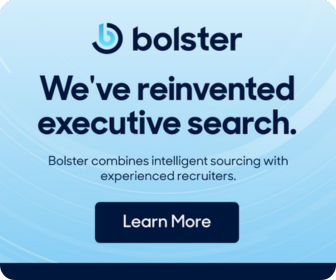
Scaling your leadership team is a vital part of scaling your company. If you haven’t thought about your hiring strategy—or if you haven’t revisited your plan recently—now is a great time to do it.
In our recent webinar, Bolster talent experts Cathy Hawley and Patti Dorsey discussed how leaders can recognize when it’s time to hire, determine which roles to prioritize, and find the right talent for their team. They provided insights from their real-life recruitment experiences, along with practical tips for scaling executive teams.
Check out these five key takeaways from the webinar to help you hire with precision.
Tip 1: Define your talent strategy
Both Cathy and Patti emphasized the importance of having a well-defined talent strategy aligned with your company's goals.
According to Patti, a talent strategy is “a company's approach to aligning their talent to meet the goals and objectives of the company. This includes a myriad of things: assessing the current talent, looking at any gaps, determining any learning and development needs that might be there with that existing staff, focusing on retention, building an inclusive culture.”
Your talent strategy should focus on fostering retention, building an inclusive culture, and mindful succession planning. Additionally, data-driven approaches, such as analyzing turnover rates, exit interviews, and employee engagement surveys, help in making informed hiring decisions.
Tip 2: Recognize the signs that it’s time to hire
Recognizing that it’s time to hire can be tricky, but there are certain signals you can look out for. Cathy referenced Startup CXO, a book co-authored by Matt Blumberg, Bolster CEO, along with several co-founders, which provides specific prompts for each role to help CEOs identify when it’s time to consider making a hire.
For example, it might be time to add a Chief People Officer if “you’re spending too much of your own time training managers and leaders, or working on interpersonal dynamics for your leadership team.”
In some cases, you might need to add an entirely new role to your team. In others, you might need to replace someone already on the team with different skills or more experience in order to help the company scale. It’s also possible you have the right person on the team, but providing them with a functional mentor could help elevate their skills.
Tip 3: Transparency is key when evaluating your current team
If you do need to replace a current leader or connect an executive with a functional mentor, having a clear leadership roadmap in place makes the process significantly easier. A leadership roadmap allows a CEO to identify the essential roles on the leadership team, evaluate where team members stand currently, and identify areas for future growth.
Cathy acknowledged, “That's a really hard conversation to have, that maybe I'm going to bring someone in above you, but the earlier you have that conversation and the more you're giving people the opportunity and the ramp to develop themselves and actually be ready for that role, the happier you're going to be and the happier your team's going to be.”
Tip 4: Be intentional about how you prioritize roles
In addition to helping you evaluate and scale your current team, a leadership roadmap helps you align your roles to the company’s stage of growth and priorities. Patti suggests, “As you look through the team, ask yourself two questions: What's the most important for the business right now, and where are the biggest gaps right now?”
There’s no one-size-fits-all answer when it comes to the order in which you should add roles to your executive team. Instead, it should be shaped by the unique needs of the business. For example, if you’re struggling to recruit or having issues with employee retention, adding a Chief People Officer may be your top priority. Alternatively, if you’re ready to ramp up your go-to-market strategies, the Chief Marketing Officer might be the most important role to fill.
Tip 5: CEO investment is key in keeping an executive hire on track
No CEO wants to spend multiple quarters looking for the perfect executive candidate. But oftentimes, the CEO is the number one driver of the efficiency of a search. When the CEO (or other hiring manager, like a Chief People Officer) is engaged in the process, prioritizes the work required to evaluate and interview candidates, and holds fast to deadlines, searches can be run quickly and painlessly.
According to Patti, the goal should always be to define expectations early in the process. “The goal is really planning and putting in the work upfront to understand what the search is going to look like, establish time commitments and touch points, and then stick to the timeline.”
Bonus Tip: Start prepping for 2024 now
Both Cathy and Patti agreed that the time to think about growing your executive team is now.
Cathy shared, “A lot of people slow down their recruiting in November and December, but you don't have to. You could start then and have somebody who starts in the middle of January. If you don't start hiring them until January, they're probably not on board until March, so you're losing a quarter of productivity and runway towards your goals for the quarter, for the year.”
When it comes to hiring—especially at the executive level—having a thoughtful plan and a clear perspective on the needs of the business is central to success. If you’re interested in hearing everything Cathy and Patti had to say, the full 25-minute session is available anytime.
Need help building your executive team?
We’re here to help. Learn more about Bolster's full-time executive search offering and how it can transform your organization's leadership team.
